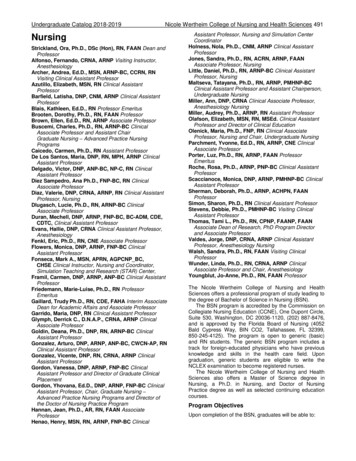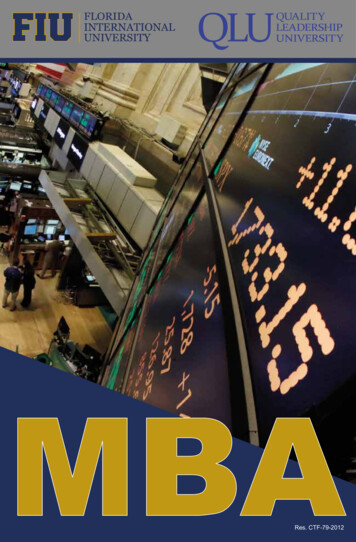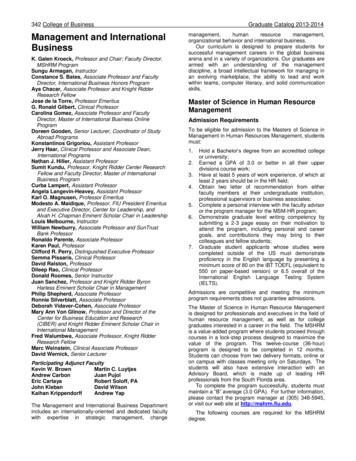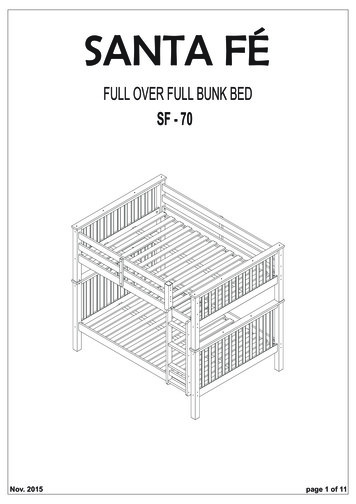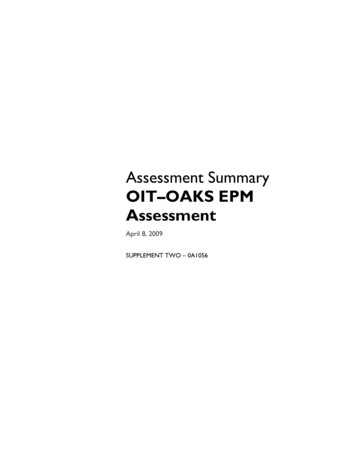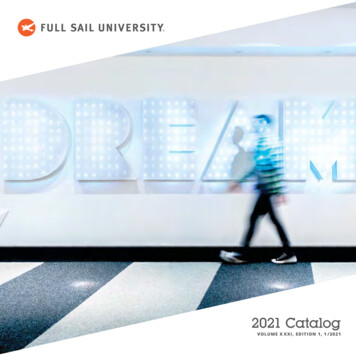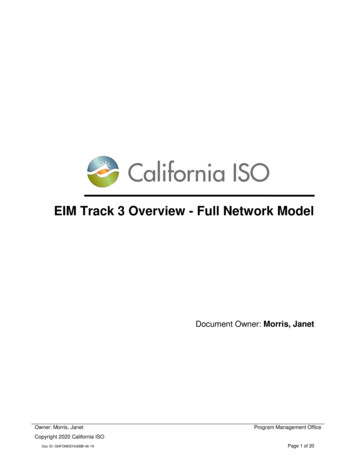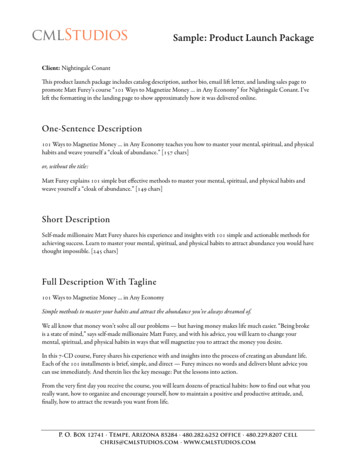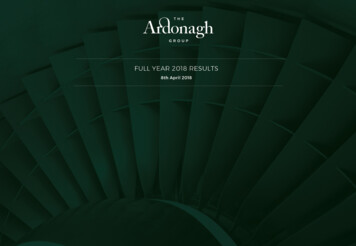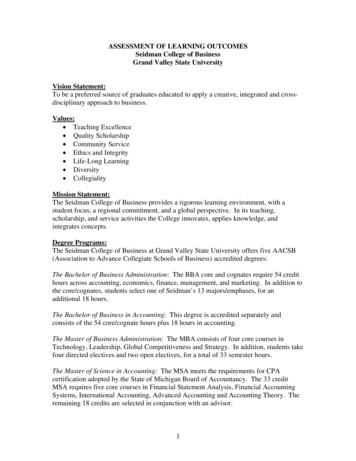
Transcription
ASSESSMENT OF LEARNING OUTCOMESSeidman College of BusinessGrand Valley State UniversityVision Statement:To be a preferred source of graduates educated to apply a creative, integrated and crossdisciplinary approach to business.Values: Teaching Excellence Quality Scholarship Community Service Ethics and Integrity Life-Long Learning Diversity CollegialityMission Statement:The Seidman College of Business provides a rigorous learning environment, with astudent focus, a regional commitment, and a global perspective. In its teaching,scholarship, and service activities the College innovates, applies knowledge, andintegrates concepts.Degree Programs:The Seidman College of Business at Grand Valley State University offers five AACSB(Association to Advance Collegiate Schools of Business) accredited degrees:The Bachelor of Business Administration: The BBA core and cognates require 54 credithours across accounting, economics, finance, management, and marketing. In addition tothe core/cognates, students select one of Seidman’s 13 majors/emphases, for anadditional 18 hours.The Bachelor of Business in Accounting: This degree is accredited separately andconsists of the 54 core/cognate hours plus 18 hours in accounting.The Master of Business Administration: The MBA consists of four core courses inTechnology, Leadership, Global Competitiveness and Strategy. In addition, students takefour directed electives and two open electives, for a total of 33 semester hours.The Master of Science in Accounting: The MSA meets the requirements for CPAcertification adopted by the State of Michigan Board of Accountancy. The 33 creditMSA requires five core courses in Financial Statement Analysis, Financial AccountingSystems, International Accounting, Advanced Accounting and Accounting Theory. Theremaining 18 credits are selected in conjunction with an advisor.1
The Master of Science in Taxation: The MST program requires 33 credits, including fivecore courses (Tax Research and Writing; Corporate Tax I; Estate, Gift, and Tax I;Partnership Taxation; and Taxation Problems). In addition, each student takes twodirected electives and four tax electives.Approach to Assurance of Learning Assessment1. Assessment should reflect the school’s vision, mission statement and values.Seidman’s vision is that our graduates will be able to “apply a creative, integrated andcross-disciplinary approach to business”. This is a new vision statement, so theseefforts are beginning. Our current Assurance of Learning Plan has a few learningobjectives that address students’ ability to integrate, and the Strategic PlanningCommittee is soliciting curricula proposals that will help us achieve our vision. Asthese proposals are approved and implemented, our learning objectives and measureswill focus on integration to a greater degree.Seidman’s mission, as well as our “Diversity” value states that we have a global focus.We are therefore assessing international/cultural knowledge in four of our five degrees,with more emphasis in the graduate programs. Our mission further states that we havea regional commitment. Our Assurance of Learning Plan uses regional employers asthe assessors for our mock interviews, and one of the cases that is used to assesslearning involves a Grand Rapids company. Seidman’s mission also stresses theapplication of knowledge. Most of our assessment measures involve the application ofknowledge in the form of case analysis, presentations, mock employment interviews,and behavioral exercises.Grand Valley State University’s Vision encompasses teaching in the liberal tradition toprovide all students, regardless of academic major, with a liberal education that“transcends the acquisition of information” and helps students develop “the skills ofinquiry, reflection, critical analysis, dialogue, and expression”. Seidman’s “TeachingExcellence” value reflects the university’s vision through its focus on liberal learning,critical thinking, expression, and independent thinking. Consequently, although wehave a few content-based learning objectives, most of our learning objectives addressliberal education skills.Finally, Seidman’s “Ethics and Integrity” value says that faculty will teach the processof ethical development. We have therefore incorporated an Ethical Reasoning learninggoal/objectives into each of our five degree programs.2. Assessment should take place at the program level and be developmental in focus.Seidman faculty members felt it was important that assessment not become a method ofevaluating faculty performance; therefore, we decided that we would not traceassessment data back to individual faculty, thus erasing motivation to inflateassessment results. We wanted faculty members to regard assessment as helpful, notpunitive.2
At the same time, we realize that there must be accountability in the process. A newSeidman requirement, introduced in Winter 2006, is that faculty members prepare ateaching portfolio to be used in teaching evaluation. As part of this portfolio,instructors will be asked to address how they are meeting each of the learningobjectives specified in the syllabus of record for each class. They will be asked toinclude assignments/tests that demonstrate the incorporation of the objectives.3. There should be heavy faculty involvement in the development of the plan and thecorrection of revealed deficiencies.Seidman wanted significant faculty involvement in the development of the Assuranceof Learning Plan. Twenty-four faculty members served on one of the four task forcesthat developed learning goals and objectives; thirty-nine faculty members helpeddevelop the measures. In total, 50 of our full time faculty and three non-regular facultymembers were involved in the development process. The complete Assurance ofLearning Plan was presented to and/or voted on by the entire Faculty Senate six times.The faculty will also be heavily involved when assessment results are presented anddecisions are made about how to correct curriculum deficiencies. If faculty membersare going to assume ownership of the plan, this is where their input and commitmentwill be most needed. Assessment Committee members, each department, and theFaculty Senate will participate in developing and approving plans to remedy anylearning deficiencies uncovered by the assessment process.4. We should adhere to the principles of good research design and sound measurementtechniques.Seidman members talked about how best to collect and process results that wouldindicate the true state of how well our students are learning designated knowledge andskills. As in any school, we know that some faculty members are more forgivinggraders than others. We also know, from a survey of faculty conducted two years ago,that visitors and adjuncts are significantly less rigorous than regular instructors. Weconcluded we would get the most accurate results if the process of course grading wasseparated from the process of assessment.We collected assessment materials across all sections of courses designated forassessment. Because we wanted consistency in measurement, we decided, for the mostpart, to use a small group of faculty who were briefed to do the actual assessment work.Had we asked that all instructors in each course assess, we would not know whetherdifferences across results were attributable to real learning differences or differences ingrading rigor.Seidman intends to keep investigating the best way to handle assessment grading. Forone measure, we used two faculty members working independently on the same studentwork to get a reliability measure. For a second measure, we did use all the instructorsin all the sections of a course to try and determine how well that approach works.3
Because we did not use a large group of assessors, we decided to use samplingprocedures for some of our measures. In order to ensure representativeness, we choseeither a population or a randomly drawn subset for most measures. Whenever we useda sample, we conducted power tests to make sure the sample size was sufficient.Assurance of Learning ProcessFollowing is a brief description of how the Assurance of Learning Plan was developedand implemented at Seidman. The AOL Director participated in each step and served onall task forces and committees.1. Learning goals and objectives were identified.The Seidman College Curriculum Committee, comprised of a faculty member fromeach department plus the Associate Dean, reviewed the BBA in 2004 and developed thelearning goals for the program. These were presented to the Faculty Senate, whichmodified and approved them.The MBA was reviewed by the MBA Committee in 2005; learning goals and objectiveswere developed by a ten-member task force of instructors who teach MBA courses.These were presented to the faculty senate, which modified and approved them.The goals and learning objectives for the BBA in Accounting, the MST, and the MSAwere developed by two separate task forces, each comprised of five Accountinginstructors. These were presented to and approved by the Accounting Department.During the process of developing goals and objectives, an AACSB consultant, KathrynMartell, was brought to Seidman to explain assessment to all faculty members. Dr.Martell held two sessions; every faculty member attended one. An AOL Director wasappointed in November, 2005 and an Assurance of Learning Committee was formed inWinter 2006. In total, 24 faculty members served on the task forces that developedlearning goals and objectives.2. Curriculum was analyzed in each core class for all degrees.Following the identification of learning objectives, the College Curriculum Committeerequested that all syllabi of record be rewritten by the groups of instructors who taughteach core class. The above mentioned committees and task forces then conducted ananalysis of core courses in each degree to ascertain how well the current curriculumwas addressing the learning objectives.Three areas of weakness were noted. The most significant deficiency in the curriculumfor four of Seidman’s degrees was coverage of ethics; it was minimally present in thevarious cores. Oral communication was also a problem in four of the degrees; althoughit was covered in many places, coverage was an individual instructor decision andtherefore not systematic. International coverage was questionable in the BBA; coveragewas scattered across a number of courses, but was the focus of none.4
3. Curriculum changes were made to address some obvious deficiencies.The Seidman Curriculum Committee and a task force of business school andphilosophy instructors designed six options to include ethics in the various degrees.Three special meetings were held by the Faculty Senate to select one of these options(or to suggest another). Following Faculty Senate approval, new course proposals andprogram changes were sent to and approved by the University Curriculum Committee.Smaller changes were made in core classes as faculty who teach them committed, viathe syllabi of record, to incorporate the teaching and measurement of skills into theirclasses. Seidman had discussed adding an international requirement to the BBA core,but decided to wait for the results of the first assessment before moving forward.4. Assessment schedules, measures, and metrics were developed.Five committees and task forces began to identify where and how assurance of learningdata would be collected. An Assessment Committee, with representatives from eachdepartment and chaired by the AOL Director, was appointed in January, 2006; thisgroup completed the planning process. The AOL Director worked with the variouscommittees and instructors to develop the necessary metrics; 39 full-time facultymembers participated in this effort.5. Assessment data is collected, graded, coded and entered.Instructors of the classes identified in the assessment plan collected data during Fall 05and Winter 06. Eighteen faculty members assigned and collected student work; 12assessors graded the work. Data was coded and entered by Seidman’s administrativestaff during Summer 06 under the guidance of the Director.6. First Assessment Results Report was written.The first report detailing and summarizing the results of assessment was written by theDirector in Summer 06.7. Results are discussed by the Assessment Committee and the full faculty.Results will be disseminated to faculty at the beginning of August and discussed at thefirst Faculty Senate Meeting at the end of August. In September, the members of theAssessment Committee will each meet with their individual departments to solicitrecommendations for curriculum improvement.8. Modifications to the curriculum are agreed upon and implemented.The Assessment Committee will consolidate the department recommendations andbring the results to the Faculty Senate in Fall 06. If major changes are needed,appropriate proposals will be forwarded to the Curriculum Committees; changes that donot involve substantial course revision, new courses, or program changes will beundertaken by faculty in Winter 07.9. The Assessment cycle repeats.Half of the learning objectives were assessed in 05/06; the other half will be done in06/07. This cycle will continue to repeat.5
ASSESSMENT BUDGETBachelor of Business e(accountingmajors only)One hourexam150 studentsDisciplinaryKnowledgeTwo jectBusinessEnvironment;Writing itical ThinkingPointAssessmentCostACC 413,414,undergradin 614Computerscored0MGT 495Computerscored0625studentsMKT 350Instructors ineach class0StrategyCase175 studentsMGT 495Two assessors 6,000EthicsCase60studentsMGT 340and 438Two assessors CriticalThinkingTestFallSemesterof SeniorYear;MGT 495180studentsMGT 340and 4386ComputerScoredSiteLicense 300 peryear
Master of Business tsMGT 631Outsideassessor?SaturnCase30studentsBUS 681TwoAssessors refourCase30studentsBUS 671TwoAssessors 2,000InformationSystemsAssignment30studentsBUS 610One Assessor0EthicalReasoningEthics Case30studentsMGT 677Two assessors MBAelectivesOne assessor0Writing er of Science in icationTaxPlanningTaxLawTaxProblemsTax ProtestLetterResearchMemoResearchMemoTax ntsACC C 636ACC 636ACC 636 300 30000
Master of Science in lCompetence;EffectiveResearchAudit Case;AccountingPracticesCase20studentsACC 620OneAssessor archPaper30studentsACC 617OneAssessor C signment15studentsACC 610OneAssessor0EthicalReasoningEthics KILLExpenses for 2005/2006:Director Summer Stipend:AssessorsTotal 9,60012,100 21,700Expenses for 2006/2007Director Summer StipendAssessorsCCT site licenseOutside AssessorBehavioral ExercisesTotal 9,8006,5003001,5002,000 18,3008
BACHELOR OF BUSINESS ADMINISTRATIONProgram: Mission, Goals and ObjectivesTo educate students so that they have a command of the basic language and skills ofbusiness, enabling them to thoughtfully participate in the decisions of the marketplaceand thereby contribute to their professions, organizations, and communities.1. A Seidman BBA graduate will be conversant in the concepts and language of the functionalareas of business. He/she will be able to: Correctly answer questions about the basic concepts and principles in the areas ofaccounting, economics, finance, management and marketing. Apply disciplinary knowledge to problem solving situations.2. A Seidman BBA graduate will recognize ethical issues inherent in the practice of business andapply the process of ethical inquiry. He/she will be able to: Identify the ethical concerns and consequences of a given business issue or problem. Apply ethical theories and models to ethical problems. Identify personal values and consciously employ those values in business decisionmaking.3. A Seidman BBA graduate will understand both the internal and external environment of abusiness organization. He/she will be able to: Identify and analyze the legal/regulatory, international/cultural, and competitive issuesthat impact a business decision. Draw from multiple disciplines when analyzing a business situation.4. A Seidman BBA graduate will be an effective communicator. He/she will be able to: Organize written thoughts into a coherent narrative free from grammar and mechanicalproblems. Engage in effective interpersonal dialogue.5. A Seidman BBA graduate will be skilled at locating, evaluating, and using informationeffectively. He/she will be able to: Demonstrate knowledge and use of various databases and library reference materials. Evaluate information and decide what is relevant and useful. Use information to answer a specific question or accomplish a specific purpose. Source information correctly.6. A Seidman BBA graduate will be a critical thinker. He/she will be able to: Draw reasonable conclusions from presented evidence. Adjust opinions in light of new information and facts. Read/listen to something and distinguish the author/speaker's major point, arguments,evidence, inference, and conclusions. Reason systematically in support of an argument with relevant reasons and examples.9
ASSESSMENT OF THE BBA PROGRAMMeasures for 2005/20061. An internally developed two-hour disciplinary knowledge test administered inconjunction with MGT 495 (Strategy) is used to assess knowledge across all businessdisciplines.2. A strategy case assigned in MGT 495 (Strategy) is used to assess organizationalcontext and written communication.3. A project/paper assigned in MKT 350 (Marketing Management) is used to assessinformation literacy.Measures for 2006/20071. The Cornell Critical Thinking test will be administered in all Ethics CategoryCourses.2. A case that measures ethical reasoning (Ethics courses)3. An interview given by area business people that assesses interpersonal oralcommunication skills; this will be assigned in several sections of MGT 495 (Strategy)Sample/Procedure:Disciplinary Test: The Director of Assessment will set aside and notify students in MGT495 of 4-5 testing periods; students must complete the test within the first three weeks ofthe Strategy class. All tests will be computer-graded. All students enrolled in Fall andWinter sections of MGT 495 will take the disciplinary test, for a sample of 300-400students.Information Literacy Assignment: Students in all Fall and Winter SWS business sectionsof MKT 350 will complete an assignment that requires the collection, evaluation and useof outside data. Instructors will fill out the Information Skills Rubric as they grade eachassignment and give them to the Director of Assessment, who will compile the data.MKT 350 is taught 25 times during Fall and Winter and enrolls 550-650 students. MKT350 does enroll significant numbers of non-business students; they will be removed fromthe sample.Strategy Case: Each year, instructors of MGT 495 will agree upon a strategic case thatwill be used in all sections. Students will hand in two copies of the case write-up.Instructors will set aside one copy and grade the other as normal for the class; a clean setwill be given to the Director of Assessment. A random sample of 100 students will bedrawn from Fall and Winter sections. This is a sample of 18-19%, which p
The Master of Business Administration: The MBA consists of four core courses in Technology, Leadership, Global Competitiveness and Strategy. In addition, students take four directed electives and two open electives, for a total of 33 semester hours. The Master of Scie

